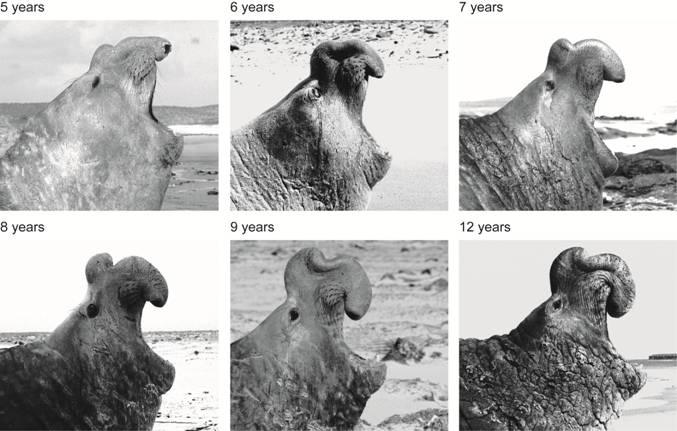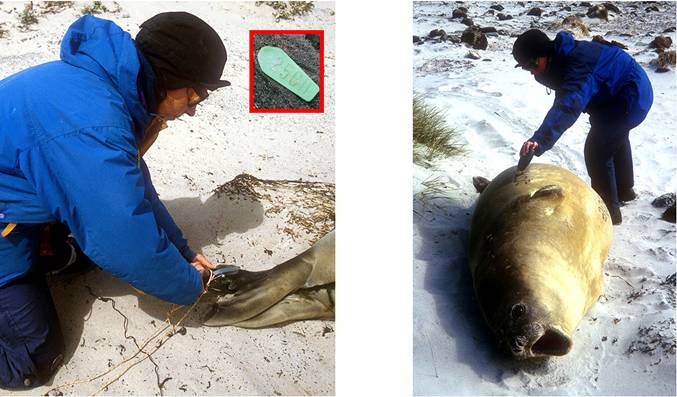Elephant Seal Survey
Survey sighting form - fill in online
Survey sighting form - download PDF file
Survey sighting form - download Word file
Information about elephant seals
The elephant seal annual cycle
The elephant seal annual cycle includes two land phases (breeding and moulting) and two phases of feeding at sea (post-breeding and post-moulting migrations, Figure 1). Elephant seals may be present on land almost along the whole year, but most seals haul out from September to March (Table 1).

Figure 1 - Elephant seals annual cycle.
Breeding happens between September and November. The first seals come ashore to breed in early September. They form groups called harems (two or more females, eventually with their pups and with one or more males in attendance). Most of the pups are born between mid September and mid November, and they are weaned after about 23 days of suckling. Most pups are already weaned by the end of November. Both breeding males and females fast while on land, and go back to sea for their foraging trip after the breeding. Weaned pups remain on land for 4-6 weeks before going to sea for their first feeding trip.

Table 1 - Elephant seals presence on land. B = breeding; M = moulting ; X = general presence.
Moulting, the process of shedding of both old fur and skin (Figure 2) happens between late November and early April, with different sex and age classes moulting at different times. Between late November and December, yearlings of both sexes and juvenile males start coming ashore for moulting, followed by adult females and then, between late February and April, by older sub-adult and adult males. Between May and August just few individuals are usually ashore, generally young individuals (1 to 4 years old) that come for their winter haul out, a sort of rest time during their long feeding migration.

Figure 2 - A typical group of moulting individuals, most of them males.
How to identify elephant seals
Relative size of three most important classes observed during the breeding, adult males, adult females, and pups, is shown in Figure 3. Please note that all the animal lengths reported in the following text are from nose to tail (hence excluding the rear flippers and the proboscis in the case of males).

Figure 3 - Relative sizes of adult males and females, and pups.
Pups
Presence on land: from mid September to November.
Elephant seal pups are aged 0-3 weeks and they are always with their mother (unless they are abandoned pups, a phenomenon that rarely happens in the southern elephant seal). They are black, 1.00 to 1.55 m long and weigh about 45 kg at birth (Figure 4, left). In just about three weeks of suckling they get to an average weaning weight of 135-140 kg, and a maximum of more than 200 Kg (Figure 4, right). Older pups can be big and fat, even though they still suckle from their mother. They may have already started to moult and may look a mixed colour between the typical pup black coat and the weanling silver-grey coat (Figure 4, right).

Figure 4 - Different stages of development of elephant seal pups. Left: a fresh pup, just after birth. Right: a 3 weeks old pup, almost ready to be weaned, and almost completely moulted.
Weanlings (= weaned pups)
Presence on land: from early October to early January.
Weanlings are aged between 3 weeks and 2 months. They are pups that have been weaned, so they are not with their mother anymore. Weanlings often stay together, forming large groups (Figure 5). Weanlings are just a bit longer than pups (1.25 to 1.70 m), but they are very fat. They can be still black just after weaning, but they soon get a silver-grey colour (Figure 6). Recently weaned pups can still be moulting from the black coat typical of pups to the silver-grey coat typical of weanlings, hence being of a mixed colour. Weanlings can be sexed only if the lay on the back and the belly is visible: females only have the umbilical scar, while males have the umbilical scar, plus the penile opening just below (Figure 7). This is also the best criterion to distinguish adult females from juvenile males, that still do not have the proboscis.

Figure 5 - A group of weanlings.

Figure 6 - Two weanling, one still with the black coat typical of pups (top), and another with the grey-silver coat (bottom).

Figure 7 - Sexing the weanlings: male with penile opening (top) and female without it (bottom). Please note the difference in size and fatness, that is sex independent.
Yearlings
Presence on land: from early November to December for the moult, but they might be seen also during the winter months, when they get to land for the winter haul out.
Yearlings are about one year of age. They are normally just slightly longer than weanlings. Their fur is brownish or creamish in colour, and they might show some sign of moulting, with pieces of fur and skin being shed. They are easily mistaken for weanlings, so particular attention should be paid in distinguishing between these two classes of individuals (Figure 8). The best way to go is to take some photos and attach them to the questionnaire.

Figure 8 - A yearling (top) and a weanling (bottom), the first smaller in size than the second.
Adult females
Presence on land: most adult females are present on land during the breeding season (September to November) and moult from late December to early January.
The typical growth pattern of females is shown in Figure 9 (right). Females are considered adult when they are about 4 years of age. They are on average between 2.3 and 2.6 m long and are from greyish to brownish in colour (colour varies a lot in different individuals). They do not present any sign of the proboscis typical of males (see Figure 3 and Figure 4).
During the breeding season it is easy to distinguish females from young juvenile males, because of the presence of pups. During these months a "female looking individual", without a pup, is probably a juvenile male. During the moulting season, females can be easily mistaken for juvenile males, since they often moult in the same places. As mentioned above, females can be distinguished from young males if they are lying on their back and showing their belly (see Figure 7).
Juvenile males
Presence on land: mostly during their moulting period, from late November to early January. During the winter months younger juvenile males may be present for their winter haul out. Also, few juvenile males may be present on land during the breeding season (September to November).
Juvenile male elephant seals are aged between 2 and 5 years. They vary in size between 1.9 and 3.0 m in length and can be cream, grey or brown in colour (Figure 10). Younger juveniles have no sign of the male proboscis, and for this reason they can be mistaken by females. The head of a juvenile male is slightly bigger, but the only safe way to be sure is to look at their belly (see Figure 7). Older juvenile males start having a hint of the typical male proboscis. The typical growth pattern of males is shown in Figure 9 (left).

Figure 9 - Elephant seal growth. Left: males. Right: females. Redrawn from Laws, R. M. (1953). The elephant seal (Mirounga leonina Linn.). I. Growth and age. Scientific Reports of the Falkland Islands Dependencies Survey 8: 1-62.

Figure 10 - A group of juvenile males sparring during the moult period.
Sub-adult and adult males
Presence on land: September to November or early December while breeding and January to April for moulting. Younger sub-adults moult before older males.
Sub-adult males are 6 to 9 years of age while adults are older than 10. They vary a lot both in length (3.7 - 5.0 m) and in colour, being from greyish to brownish. They are clearly bigger than females, and they have the proboscis (Figure 11).

Figure 11 - Male proboscis growth. The same male is shown, at increasing age.
Tags and marks that could be found on elephant seals
The ESRG has tagged and dye marked elephant seals at Sea Lion Island during the past twenty years. A sample of the tag colours used at Sea Lion Island is depicted in Figure 12.

Figure 12 - A sample of tag colours and prints that were used to mark Sea Lion Island seals.
Tagging is carried out by placing plastic cattle tags with different colour and print in the membrane of the rear flippers (Figure 13, left). Each seal usually bears at least two tags, and tags loss rate is very low. Tag observations give very valuable information about seals movements and dispersion. If you are reporting a tag sighting, please note the colour, on which flipper (left or right) the tag was, and try to read the print. Even incomplete reports, with a partial print reading, or just the colour and flipper are useful.

Figure 12 - Marking of elephant seals. Left: tagging of a weaned pup. Right: dye marking of a breeding female.
Dye marking is carried out using hair dye: names are painted on the side, back, and/or belly of the seal (Figure 13, right). These marks last for the whole breeding season but disappear during the moult. Vagrant individuals coming from King George island sometimes have a brand mark and bigger flipper tags.
How to report an elephant seal sighting
You have different options. The best way to go is to fill up the attached sighting form. The form can be:
- printed, hand filled and mailed to our address: Dr. Filippo Galimberti, ESRG, Sea Lion Island
- printed, hand filled, scanned and emailed to us, fil_esrg@eleseal.org
- filled in electronic format (Word, Acrobat) and emailed to us, see above
- use the online form (link below)
If you are not comfortable at filling up the form you can just mail or email to us a note, but please remember to include the minimum information, i.e., when and where you saw the elephant seals, and how many they were. Any additional information about sex and composition of the group(s) is very useful. Coordinates of the sighting will also help us in inputting your observation into our Geographic Information System. Any picture of elephant seals observed and/or tags and marks is also very useful.
Survey sighting form - fill in online
Survey sighting form - download PDF file
Survey sighting form - download Word file
